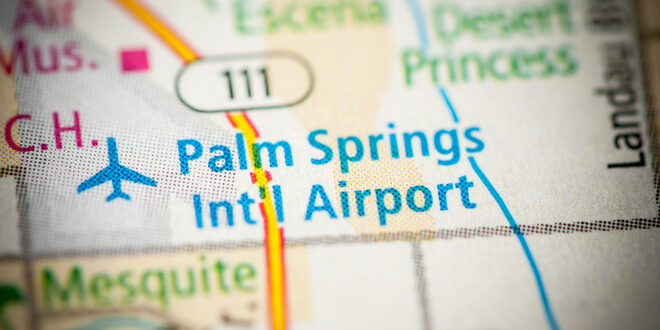Palm Springs has unanimously approved a plan that will determine growth and development at Palm Springs International Airport.
The city council last month unanimously adopted the Palm Springs International Airport Master Plan, which outlines the size, scale, and location of airport components like terminals and parking.
The plan’s goal is to make certain the city-owned airport meets the growing demand for air travel among Coachella Valley residents, while preserving the airport’s historic traits and character, according to a statement on the city’s website.
“With the city council’s approval, Palm Springs International takes another step forward, ensuring it remains not only a gateway for travelers but a source of pride for the communities we serve,” Harry Barret Jr., the airport’s executive director, said in a statement. “We’re laying the groundwork for community-focused growth while ensuring the airport reflects the values of Palm Springs and the Coachella Valley.”
The Federal Aviation Administration requires that airports periodically draw up a plan that assesses their strengths and weaknesses, and to outline their intentions for future development, said Jake Ingrassia, airport spokesman.
While the report describes the size and location of future development, it does not address how any of the projects will be paid for. However, projects the size and scope of a municipal airport expansion typically rely heavily on government funding.
The approved plan calls for new gates, an expanded baggage area and a “hybrid” rental car center. The latter will consist of a single-story building with two below-ground levels, to be built north of the airport’s lone terminal, next to the baggage-claim facility.
A second structure south of Kirk Douglas Way could be added in the future, if the demand for rental cars grows.
“Our rental car facilities are decentralized,” Ingrassia said. “They’re all over the place, and some people drive through residential neighborhoods when they return their cars. It has to be consolidated.”
Considering Palm Springs International’s recent passenger growth, a second rental car structure seems likely.
The airport attracted 3.2 million air travelers in 2023 and again in 2024, according to the Palm Springs International Airport Commission, the 19-member board that advises the city council.
Those numbers are expected to rise to four million in 2027, 4.7 million in 2032, 5.5 million in 2037 and 6.4 million in 2042, Ingrassia said.
Right now, the airport can comfortably handle about 1.5 million passengers a year, according to Ingrassia.
“When things get busy, especially in March or April, the rental cars are difficult to deal with,” Ingrassia said. “It gets to be almost more than we can handle. We have to do something, and we have to start doing it now.”
Like Ontario International Airport, and San Bernardino International Airport, Palm Springs International can trace its roots to the U.S. military.
Built by the U.S. Army Corps of Engineers, what eventually became Palm Springs International started out as an emergency landing field in 1939, two years before the United States entered World War II. It was the the first airport built in Riverside County, on a site leased at the time by the federal government to the Agua Caliente Band of Cahuilla Indians.
The land was chosen for its dry weather and calm winds, according to a history of the airport included in 2015 Master Plan.
The Corps of Engineers built two runways next to each other, a taxiway, and an aircraft parking ramp. More runways were built as it became more likely that the U.S. would go to war. When the war ended in 1945, the runways and parking ramps were decommissioned and handed over to the city.
In 1961, Palm Springs bought the airport from the tribe, which by then owned the property, for $1.5 million. Scheduled air carrier service started at Palm Springs Municipal Airport in 1964, and the airport established an air traffic control tower three years later to handle increased traffic.
In 1986, the airport’s name was changed to Palm Springs International Airport.
Today, the airport is owned and operated by the city of Palm Springs. It covers approximately 940 acres two miles east of downtown Palm Springs, has two runways and handles most of its flights in the winter, spring and fall
Twelve airlines serve Palm Springs International, providing year-round and seasonal nonstop flights to more than 30 destinations.
Construction on the projects in the plan will not begin immediately.
The city council’s yes vote marks the completion of the plan’s conceptual phase. Now, the plan must pass the regulations established by the California Environmental Quality Act, an often difficult and complicated process that is expected to take at least 12 to 18 months, according to an airport statement.
Once that process is complete, design, financial analysis, and other preparatory work will begin.
Work on the first phase of terminal upgrades could begin in the next three to four years. Those improvements will include seven new gates, the rental car center, a federal inspection station for international travel, and an expanded baggage claim. Those upgrades could be ready by the early 2030s, according to the statement.
Three open houses, and nearly 40 outreach presentations, have been held since July 2022, when the city council approved the plan’s initial scope. Most of the presentations were held with city councils in the Coachella Valley, community groups, local businesses, and airport tenants.
The city plans to hold similar public forums as the plan is put into place, according to the statement.
 IE Business Daily Business news for the Inland Empire.
IE Business Daily Business news for the Inland Empire.


